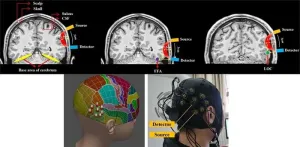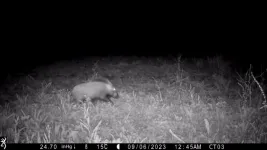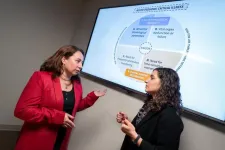(Press-News.org) The brain is not only the most complex organ of the human body, but also one of the most difficult to study. To understand the roles of different regions of the human brain and how they interact, it is crucial to measure neuronal activity with awake subjects while they perform controlled tasks. However, the most accurate measurement devices are invasive, which greatly limits their use on healthy humans in real-life settings.
To overcome this major obstacle, scientists have come up with ingenious techniques to measure brain activity in safe and noninvasive ways. One prominent example is functional magnetic resonance imaging (fMRI), which uses strong magnetic fields and radio waves to map changes in blood flow in the brain. A major drawback of fMRI is the size and cost of the necessary equipment, which restricts its more widespread adoption in laboratory and clinical settings. Fortunately, a different technique called functional near-infrared spectroscopy (fNIRS) has been gaining traction. This method involves placing a light source and detector on the scalp to measure localized changes in hemoglobin concentration, which correlate to brain activity. Despite its advantages, which include simplicity and portability, the true potential of fNIRS remains unexplored in many regions of the brain.
Previous studies have used fNIRS to detect brain activity in the ventral visual pathway, but none have evaluated its feasibility and ecological validity, or whether the signal detected is desirable. Against this backdrop, a research team including Professor Minghao Dong from Xidian University, China, together with Professor Chaozhe Zhu from Beijing Normal University, set out to test the capabilities of fNIRS for measuring brain activity in the lateral occipital complex (LOC) and the fusiform face area (FFA), two key regions in what is known as the ventral visual pathway. Their study is published in the Gold Open Access journal Neurophotonics.
To understand the experiments, it helps to know the functions of the LOC and FFA. The LOC plays a crucial role in object recognition; its neurons are involved in processing information about the shapes and forms of objects. On the other hand, the FFA is specialized in the processing and recognition of faces. Compared to the FFA, the LOC is much closer to the scalp. Thus, the team hypothesized that fNIRS measurements were more likely to be successful in this region than on the LOC.
To test this hypothesis, the researchers recruited 63 adult subjects, of which 35 were included in the current study, while the other 28 were included in a follow-up study, the results of which matched those in the current study but were not mentioned in the publication. The team conducted several object- and face-recognition tasks while performing fNIRS measurements using a portable instrument. The idea was to check if the corresponding brain region would exhibit activity in response to images of objects or faces that the subject had seen previously during the experiment. Worth noting, the team employed a tool called the “transcranial brain atlas,” which they had developed in a previous study, to determine the optimal placement of the instrument’s sensors for each individual subject. Moreover, the current study provides valuable insights by demonstrating that placing the target channel corresponding to the target coordinates is sufficient for measuring LOC activity, eliminating the need for additional supplementary channels around the target coordinates.
The results matched the researchers’ expectations, as Dong remarks: “According to our findings, the LOC target channel selectively activates in reaction to objects, whereas the FFA target channel does not.” The most likely explanation is that the depth at which the FFA is located exceeds the detection threshold of fNIRS. “The LOC region appears to be a suitable target for fNIRS-based detection, despite the fact that fNIRS detection has limitations in collecting FFA activity,” adds Dong.
Overall, the research team’s efforts represent a step towards better techniques with which to study the brain. “Our results help understand the feasibility of fNIRS for practical applications. To the best of our knowledge, this work is the first to examine the viability of the technique in monitoring cortical activity within the ventral visual pathway,” concludes Dong.
Further advances in fNIRS technology could lead to practical, low-cost diagnostics for certain brain disorders, as well as potential avenues for neuroenhancement devices. Such equipment would enable us to augment specific cognitive functions or help treat neurological conditions.
Only time will tell what fNIRS may hold for the future of neuroscience!
For details, see the original article by Chai, Zhang, et al., “Feasibility study of functional near-infrared spectroscopy in the ventral visual pathway for real-life applications,” Neurophotonics 11(1) 015002 (2024), doi 10.1117/1.NPh.11.1.015002.
END
Using spectroscopy to measure visual recognition
Researchers explore the applicability of functional near-infrared spectroscopy in two key visual regions of the brain
2024-01-08
ELSE PRESS RELEASES FROM THIS DATE:
New research aims to develop novel therapeutic for glaucoma
2024-01-08
INDIANAPOLIS—Researchers at Indiana University School of Medicine are using a novel approach to hopefully develop a new therapy for glaucoma, a complex disease that eventually leads to blindness, thanks to a new five-year, $2 million R01 grant from the National Eye Institute.
“Glaucoma is a silent, underdiagnosed, costly and debilitating disease,” said Tasneem Sharma, PhD, assistant professor of ophthalmology and lead investigator on the project. “It occurs when there is ...
Roundtable on efforts toward achieving health equity
2024-01-08
In the Roundtable titled “A Glimpse at How Stakeholders Are Working Towards Achieving Health Equity,” published in the peer-reviewed journal Health Equity, two expert panel discussions examine efforts to achieve maternal health equity and changes that health systems can make to operationalize health equity. Click here to read the Roundtable now.
The moderator of the panel discussion titled “Efforts to Achieve Maternal Health Equity Today” is Laurie Zephyrin, MD, MPH, MBA, Senior Vice President, Advancing Health Equity, The Commonwealth Fund. The discussion focuses on what health systems can ...
100 years of lifesaving work and counting: Happy Birthday to the American Heart Association
2024-01-08
Embargoed until 1 p.m. CT/2 p.m. ET Monday, Jan. 8, 2024
DALLAS, Jan. 8, 2024 — From humble beginnings as a small professional health society formed by six cardiologists in Chicago in 1924, the American Heart Association has emerged as the nation’s oldest and largest voluntary organization dedicated to fighting heart disease and stroke. Uniting more than 35 million volunteers and supporters and more than 2,900 employees, the Association today is a global force transforming the way the world understands, treats and prevents cardiovascular and cerebrovascular ...
Virginia Tech researchers find drugs used to treat Type 2 diabetes reduce alcohol cravings, use in individuals with obesity
2024-01-08
In social media posts on the community network Reddit, users reported reduced cravings for alcohol when taking drugs intended to treat Type 2 diabetes and obesity.
Across a number of threads — with titles such as “Did scientists accidentally invent an anti-addiction drug?” and “I don't know if this is a side effect but ... Mounjaro makes me drink less!!!!!” — users reported a changing relationship with beer, wine, and liquor.
An analysis of those posts, together with a remote study of individuals with obesity who reported using semaglutide ...
Rensselaer researcher helps scientists make sense of vast amounts of molecular data
2024-01-08
Thanks to technological advances, scientists have access to vast amounts of data, but in order to put it to work and draw conclusions, they need to be able to process it.
In research recently published in Genome Biology, Rensselaer Polytechnic Institute’s Boleslaw Szymanski, Ph.D., Claire and Roland Schmitt Distinguished Professor of Computer Science and director of the Network Science and Technology Center, and team have found a method that effectively organizes and groups the data for a variety of applications. The process is referred to as clustering ...
Solid state battery design charges in minutes, lasts for thousands of cycles
2024-01-08
Researchers from the Harvard John A. Paulson School of Engineering and Applied Sciences (SEAS) have developed a new lithium metal battery that can be charged and discharged at least 6,000 times — more than any other pouch battery cell — and can be recharged in a matter of minutes.
The research not only describes a new way to make solid state batteries with a lithium metal anode but also offers new understanding into the materials used for these potentially revolutionary batteries.
The research is published in Nature Materials.
“Lithium metal anode batteries are considered the holy grail ...
Andalibi to receive funding for Perthera Tissue Bank
2024-01-08
Andalibi To Receive Funding For Perthera Tissue Bank
Ali Andalibi, Senior Associate Dean, College of Science, is set to receive funding for: "Perthera Tissue Bank."
FFPE samples from Perthera will be housed in the cold room in the Institute for Advanced Biomedical Research (IABR). The Principal Investigator, Co-Investigator, and the staff member will be checking on the samples on a regular basis to ensure that the samples are safely stored and that the storage conditions, such as temperature, are appropriate. ...
How did the bushpig cross the strait? A great puzzle in African mammal biogeography solved by genomics
2024-01-08
In the ongoing biodiversity crisis, large terrestrial animals are more threatened by extinction than any other group of organisms. The African continent holds an impressively intact large-mammal community, but there is still a lot we do not know about how these species evolved, became diverse and adapted to the changing climate and habitats. Many of these questions can be addressed by investigating the genomes and genetic variation across species.
New research, published in Nature Communications, uses genomics to answer ...
Acute pediatric critical illness definition enables global research
2024-01-08
(MEMPHIS, Tenn. – January 05, 2023) St. Jude Children’s Research Hospital investigators collaborated with a global group of acute pediatric critical illness experts to reach a consensus definition of the condition. Research on how to improve care in low- and middle-income countries has been stymied because conventional pediatric critical illness definitions are not applicable in these settings. The new, more universal definition, reached by consensus among researchers and clinicians from 40 countries, will enable scientists to study pediatric critical illness more universally, which should lead to improvements in patient outcomes ...
A new book provides a roadmap for food systems transformation in Kenya
2024-01-08
The past few years have seen Kenya, along with many other countries, confronted with multifaceted and compounding challenges. The disruptions caused by COVID-19, high levels of food price inflation, and environmental crises, such as locust infestations and droughts, have severely tested the resilience of Kenya’s food systems and the affordability of food for its citizens. Against this backdrop of challenges and ongoing demographic shifts, urbanization, and stagnating agricultural production, ...
LAST 30 PRESS RELEASES:
Making lighter work of calculating fluid and heat flow
Normalizing blood sugar can halve heart attack risk
Lowering blood sugar cuts heart attack risk in people with prediabetes
Study links genetic variants to risk of blinding eye disease in premature infants
Non-opioid ‘pain sponge’ therapy halts cartilage degeneration and relieves chronic pain
AI can pick up cultural values by mimicking how kids learn
China’s ecological redlines offer fast track to 30 x 30 global conservation goal
Invisible indoor threats: emerging household contaminants and their growing risks to human health
Adding antibody treatment to chemo boosts outcomes for children with rare cancer
Germline pathogenic variants among women without a history of breast cancer
Tanning beds triple melanoma risk, potentially causing broad DNA damage
Unique bond identified as key to viral infection speed
Indoor tanning makes youthful skin much older on a genetic level
Mouse model sheds new light on the causes and potential solutions to human GI problems linked to muscular dystrophy
The Journal of Nuclear Medicine ahead-of-print tip sheet: December 12, 2025
Smarter tools for peering into the microscopic world
Applications open for funding to conduct research in the Kinsey Institute archives
Global measure underestimates the severity of food insecurity
Child survivors of critical illness are missing out on timely follow up care
Risk-based vs annual breast cancer screening / the WISDOM randomized clinical trial
University of Toronto launches Electric Vehicle Innovation Ontario to accelerate advanced EV technologies and build Canada’s innovation advantage
Early relapse predicts poor outcomes in aggressive blood cancer
American College of Lifestyle Medicine applauds two CMS models aligned with lifestyle medicine practice and reimbursement
Clinical trial finds cannabis use not a barrier to quitting nicotine vaping
Supplemental nutrition assistance program policies and food insecurity
Switching immune cells to “night mode” could limit damage after a heart attack, study suggests
URI-based Global RIghts Project report spotlights continued troubling trends in worldwide inhumane treatment
Neutrophils are less aggressive at night, explaining why nighttime heart attacks cause less damage than daytime events
Menopausal hormone therapy may not pose breast cancer risk for women with BRCA mutations
Mobile health tool may improve quality of life for adolescent and young adult breast cancer survivors
[Press-News.org] Using spectroscopy to measure visual recognitionResearchers explore the applicability of functional near-infrared spectroscopy in two key visual regions of the brain






